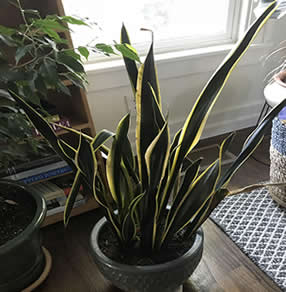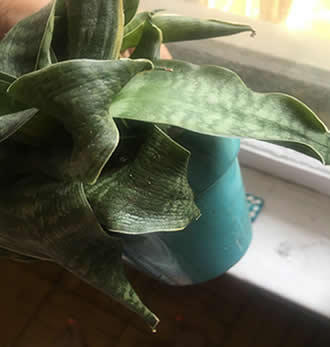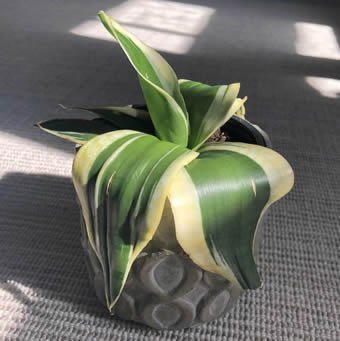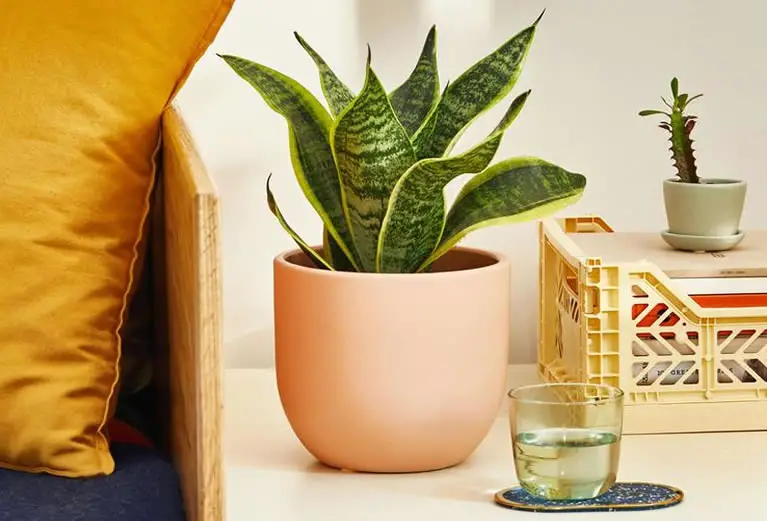In this guide, we’ll tell you everything you need to know about watering your snake plant, from how often it should be watered to how to actually water it. We also cover the the common problems associated with an incorrect watering routine and address the steps you need to take to fix any watering issues with your plant.
Table of Contents
Snake Plant Watering Guide
By the time you’re done reading, you’ll know exactly when to water your snake plant, how often to water it and what way to water so you grow a healthy succulent.
Firstly let’s address the main issue, how often should you water a snake plant?
Snake plants require watering when the soil is mostly dry.
Generally this will be once every 2 – 3 weeks.
Since snake plants are succulents that are quite drought tolerant, it is better to go longer periods without watering your plant rather than watering it too often.
Underwatering can be fixed easily by increasing your watering schedule while overwatering leads to dangerous root rot.
Snake plant watering basics
When searching for a houseplant for a corner office or living space many people opt for the snake due to its visual appeal and easy-care nature.
If you have been captivated by the snake plant’s tall, blade-like fronds (that have earned this plant nicknames like “the mother-in-law’s tongue” and “viper’s bowstring”) then you will no doubt want to know how often to water this succulent.

So, to keep your snake plant healthy, how often should you water it and what way should you water it?
Let’s look at these issues now starting with how you should water a snake plant.
How to water snake plants correctly from the bottom
You’ve heard of a watering technique known as reverse-watering or bottom watering.
So, you may be wondering if you can bottom-water your snake plant, especially considering you don’t want to overwater it (more on that later).
Do snake plants like to be watered from the bottom or the top?
Snake plants like to be watered from the bottom.
A snake plant does not like its foliage getting wet and its roots tend to grow towards moisture in the soil.
Therefore to protect foliage and ensure strong downward growing roots, bottom-watering is the best way to water a snake plant.
If you do not understand the difference between top watering and bottom watering let me briefly explain.
Bottom watering a little bit more, then we’ll delve into why this is a viable watering method for a snake plant.
When you bottom-water a houseplant, you fill a bowl, basin, or bathtub (depending on the size of the plant) with enough water so the water level does not come up the the top of pot.
With most standard sized houseplants this is usually 1 inch of water but if you have a large snake plant then you will need more water.
Just remember to keep the water at a level where it does not seep over the sides of the pot and into the soil.
You then stand the potted plant in the water.
Water will enter the plant’s pot from the drainage holes in the bottom reaching the roots from the bottom up rather than the top-down (when you use a watering can).
This ensures that the water doesn’t have to go through inches of soil to get to the plant’s roots and also protects the leaves from getting wet.
If you have a houseplant that doesn’t like getting its leaves wet, like a snake plant, then watering from the bottom is always the best option.
In addition to protecting the foliage of a snake plant from water, watering the plant from the bottom also helps keep the roots strong and healthy.
Snake plant roots tend to grow towards the moisture in the soil.
As snake plant soil should be allowed to dry out before the plant is watered this mean watering from the bottom ensures more moisture stays in the lower layers of soil for longer.
This also ensures the roots grow in a healthy downward manner.
Bottom-watering your houseplants should not occur any more regularly than you would water the plant using other methods.
It’s simply an alternate watering method.
How often you should water snake plants
Snake plants are a common sight in many indoor gardens not only because of their beauty but also due to them being an easy-care houseplant.
Basically, many people flock to the snake plant because it has a reputation of being hard to kill. Just one reason you see it in so many offices where plant care is of very little priority.
Indeed the snake plant, botanical name Dracaena trifasciata and sometimes also referred to as Sansevieria trifasciata, is tolerant of neglect.
This is due to its capacity to remain healthy for long periods of time without water and the other care essentials that are vital for many other houseplants.
How long can a snake plant go with water?
Snake plants can go as long as 6 weeks without water before any signs of distress.
Even then they will recover quickly once a regular watering routine is restored.
However, it is best not to leave a snake plant any longer than 3 weeks without watering it if you want to keep the plant healthy.
Although the snake plant is hard to kill and easy to care for I do not recommend testing its capacity for long periods of drought! To keep your plant healthy you need to know when to water it.
Follow the signs in the soil not a set watering schedule
You should only water a snake plant when most of its soil dries out.
Some plant owners wait until this houseplant’s soil is completely dry and that’s fine too though I prefer not to wait that long.
How do you know how dry or wet the snake plant’s soil is?
Well, you have to use what I cann the finger test. This involves sticking you index finger into the soil.
Normally, with succulents you would do this up to the first knuckle (as shown in the image below) as this is approximately 2 inches which represents the top layer of soil.

Checking the moisture levels in the top layer of soil is usually sufficient for most succulents.
However, as the snake plant is very drought-resistant don’t be afraid to stick your finger further down up to the third knuckle.
A snake plant can go longer periods without water than many other succulents and much more of the soil can be allowed to dry out before you need to water the plant.
So what are you looking for when you stick your finger in the soil?
Many gardeners will be able to feel moisture in the soil when they perform this action but personally, even after many years of doing this, I find it difficult to tell.
The easiest way to tell if the soil is moist is by examining your finger when you remove it from the soil.
If your finger is dirty and has soil residue on it then this indicates moisture is present but if your finger is dry and dirt-free then this indicates the soil is dry.
If some of the soil is even little bit moist you can forgo watering but if the soil is dry then now is the time to water your snake plant.
When watering your snake plant–or any houseplant, really–there’s no need to follow a set schedule.
In fact, that’s an almost surefire way to ensure you overdo it on the watering as it will become all too easy to water your snake plant at the time you water your other, non-succulent, houseplants.
Remember, the snake plant can, and should, go much longer periods without being watered than the vast majority of your other houseplants.
Another reason you shouldn’t water a snake plant on a schedule is that its needs change throughout the year.
It is likely that in the summer, your snake plant will need more water than it will in the winter.
Having said that though, some snake plants will require more watering in the winter if they sit close to heat source such as a radiator or a HVAC outlet.
How can you tell when a snake plant has been underwatered?
Signs of incorrect snake plant watering – underwatering & overwatering
I mentioned in the intro that it’s better to take a more cautious approach to watering your snake plant than it is to douse the plant in water every other day.
Yet as drought-tolerant as the snake plant is, even it has its limits.
You must get your watering routine correct for a snake plant by following the advice I gave above or your plant could experience a whole host of problems.
How do you know if your snake plant is begging for water or that it is drowning in too much water?
Before I list the exact symptoms for both underwatering and overwatering and how to fix them.
I will quickly describe each common incorrect-watering symptom now though because, as strange as it may seem, both underwatering symptoms and overwatering symptoms on a snake plant look very similar.
So, here are some signs to keep an eye on.
Snake plant slow growth
Admittedly, this first sign isn’t the best gauge when it comes to the snake plant since the Sansevieria trifasciata is a notoriously slow-growing plant anyway.
Per season, you should only expect to see several inches of growth from the snake plant.
Plus, the snake plant is dormant during the winter, which is another reason not to water it too much during the cold season.
If you already have a good gauge on how your snake plant grows because yours is a few years old, then you’ll be able to tell when it’s stopped growing.
For snake plant beginners though, they won’t know whether their plant has stopped growing because it’s being underwatered, overwatered or for some other reason. For example the plant may be in need of some fertilizer (10-10-10 liquid feed is best).
If your snake plant stops growing make sure you perform the finger test before every watering season to be completely confident the plant needs water.
Nonetheless, reduced growth is a sign that your snake plant may need more hydration.
Water is a critical part of photosynthesis, which is how a plant gets its energy.
Without water, it’s hard for a snake plant to have the energy to sustain its current growth let alone to grow anything new.
Snake plant brown leaves or brown tips
Snake plants come in many exhilarating varieties, but none should have brown leaf tips or fully brown leaves.
If your plant is developing brown leaf tips, or even brown mushy leaves, this is your plant’s way of telling you that something is wrong.
Although brown leaf tips can sometimes be a symptom of leaf burn, when a snake plant is left is strong direct sunlight, more often than not browning leaves are an indication of overwatering.
Snake plant wilting
As we said in the paragraphs above, without water for photosynthesis, a houseplant like the snake plant cannot support its current growth.
This causes the snake plant to begin wilting.
While you can sometimes miss wilting in some low-hanging houseplants, with the snake plant, it’s very obvious.
Its tall leaves will begin to lean like the Tower of Pisa.
You should therefore be able to spot this problem and deal with quickly before too much damage is done to your plant.
Snake plant wrinkled leaves
Just as your skin can feel dry to the touch if you’ve spent too much time in the sun and are dehydrated, the leaves of your snake plant can have a similar look and feel when dehydrated.
The texture of the snake plant’s leaves, while usually firm, will become shriveled instead.

This wrinkling effect is often accompanied by leaf wilting.
What an underwatered snake plant looks like
As I will explain later the symptoms of an underwatered snake plant often mimic the very same symptoms of an overwatered snake plant.
The symptoms below could be signs that your snake plant has been underwater.
However, because the snake plant is so drought-resistant, and because the symptoms of underwatering are similar to those of overwatering, I strongly urge you to check your plant for overwatering before watering it because you assume it is underwatered.
Symptoms of an underwatered snake plant include:
- Yellowing leaves.
- Limp or wilting leaves.
- Wrinkled leaves.
- Loss of foliage.
- Dry soil.
The signs of dehydration are common among most living organisms on earth and so it should not be too difficult for you to determine if your plant is dehydrated or not.
All the above symptoms, when they are accompanied by completely dry soil, are a very strong indication that your snake plant is being underwatered.
If you’re testing the moisture levels in the soil with your fingertips, then you should notice that it’s dry before you see any of the issues with your snake plant listed above.
If however you have left your plant unattended and unwatered for a very long period of time, for example over 6 weeks, then your snake plant is almost certainly in need of a cool drink of water!
Also be aware that if your plant’s soil is too compacted, then water can have a hard time getting to the roots, also prohibiting oxygen from getting through. This is a good reason to repot a snake plant every 2 – 3 years.
Although all the above symptoms are indicators of dehydration, underwatering is not the only way to cause a snake plant to dehydrate – overwatering can have the same effect!
As I am about to explain, dehydration can also be caused by root rot which occurs when a snake plant is overwatered.
If your snake plant soil is moist and you see any of the aforementioned symptoms then it is almost a certainty your plant is being overwatered.
What an overwatered snake plant looks like
Some indoor gardeners like to think they are veering on the side of caution, so they water their houseplants every other day or even every three days.
However, when it comes to a succulent, especially a snake plant. this is actually overwatering your plant.
Although overwatering creates dehydration in a snake plant just as underwatering does, overwatering is a much more severe problem.
Now, I am not trying to say that underwatering isn’t an issue, because of course it is.
You can kill your plants by starving them of water.
But, you will kill a snake plant a lot quicker by overwatering it than you will by underwatering it.
Additionally, the problems caused due to underwatering have one simple easy fix – you simply water the plant and increase your watering frequency.
Fixing the same problems due to overwatering is far from an easy fix.
In fact, if the plant has been over watered regularly for a long time it may not be possible to save it.
The reason? Snake plants are very sensitive to overwatering.
Giving a snake plant too much water leads to a plant disease known as root rot.
The reason the disease is called root rot is that this is exactly what is occurring underneath the soil – the roots of your plant are rotting away.
Root rot is one of the biggest causes for a snake plant dying.
Overwatering more often than not leads to root rot
When root rot takes hold on a snake plant the roots of the plant will blacken, and one by one, they will die.
As the roots begin to rot, even before they have died, they become unable to absorb moisture from the soil and thus cannot distribute that water to the rest of the plant.
The snake plant literally becomes dehydrated while sitting in a multitude of water.
All houseplants require oxygen and water to survive, just like we do.
So when you choke out the plant’s supply of oxygen and water, by killing the roots after flooding them with too much water, the plant begins to die.
Rot root can start without you even realizing that something is wrong because the problems start below the soil surface and take time to manifest on the outer plant.
As the disease becomes more advanced your snake plant’s leaves will begin to discolor.
Wilting will occur, as will stunted growth and eventually a loss of foliage.
Often when you see these symptoms the root rot has become a major problem and immediate action must be taken to save the plant.

When your snake plant has no healthy roots left, it’s done for.
However, you can save a snake plant from root rot if you catch it early enough.
If you notice symptoms of dehydration your first action should be to check the moisture in the soil.
Moist soil, along with signs of dehydration in a snake plant is a sign of root rot.
When a snake plant is suffering from root rot you must take immediate action or you will lose your plant.
You will will have to remove the plant from its pot in order to access the root ball.
You must then trim away all blackened, dead roots using clean pruning shears and a sharp knife.
I always use a new pot when repotting any plant that I have treated for root rot in case there have been other factors, such as soil contaminants like fungal infections, behind the root rot.
Having said that, this may not be a necessary step for you.
I only do this because in most cases I do not know the history of the plant I am treating.
If you know that the root rot in your snake plant has been caused by overwatering then you can repot your snake plant in its original pot as long as you use fresh soil.
If you are concerned that other factors may have been involved in your snake plant developing root rot then you should either dispose of the pot it was in or wash it thoroughly.
You can wash the old pot for use with another plant at a later time. Before you do that though you must use detergent and a little bleach and be sure you thoroughly clean it and rinse away all chemicals afterwards.
I just find this way too much trouble and simply dispose of the pot if I am in any doubt about the root rot causes.
Snake plant root rot fix
Before you treat your snake plant prepare your new pot and soil as explained in the previous section.
Mist the fresh only! Do not soak it in water.
If you do not have access to a water mister then leave the potted soil in a basin of water, ensuring the water does not reach the upper sides of the pot.
Allow the soil to water from the bottom for about 10 minutes only.
Once you have treated your plant you can pot it.
Once you have removed all dead roots from your snake plant, and all mushy parts of the root ball are eliminated, you need to repot your snake plant in your prepared fresh soil .
Then place it in a warm environment that gets a lot of good indirect light.
When treating a plant with root rot I will always use a grow light, especially during the early stages of its recovery, to ensure the plant is getting as much of a helping hand as possible.
I am also very, very conservative in my watering routine, allowing the soil to almost completely dry out before watering the recovering plant.
I have detailed instructions for treating root rot in succulents in the article aloe vera root rot.
All the information that this article contains applies to treating root rot in succulents.
So, you can follow the instructions exactly to treat root rot in your snake plant.
Now I should state here that overwatering is not the sole cause of root rot. Pests and disease can also be factors.
However, I have found over the years that in about 90% of cases, root rot in succulents is due to overwatering.
To be on the safe side though, after treating any plant for root rot I always use a new pot just in case there were other factors (such as disease) that contributed to the root rot.

